Analysis of Quadratic Functions
In this section, we will investigate quadratic functions further, including solving problems involving area and projectile motion. Working with quadratic functions can be less complex than working with higher degree polynomial functions, so they provide a good opportunity for a detailed study of function behavior.Intercepts of Quadratic Functions
Much as we did in the application problems above, we also need to find intercepts of quadratic equations for graphing parabolas. Recall that we find the y-intercept of a quadratic by evaluating the function at an input of zero, and we find the x-intercepts at locations where the output is zero. Notice that the number of x-intercepts can vary depending upon the location of the graph. Number of x-intercepts of a parabola
Number of x-intercepts of a parabolaHow To: Given a quadratic function [latex]f\left(x\right)[/latex], find the y- and x-intercepts.
- Evaluate [latex]f\left(0\right)[/latex] to find the y-intercept.
- Solve the quadratic equation [latex]f\left(x\right)=0[/latex] to find the x-intercepts.
Example: Finding the y- and x-Intercepts of a Parabola
Find the y- and x-intercepts of the quadratic [latex]f\left(x\right)=3{x}^{2}+5x - 2[/latex].Answer: We find the y-intercept by evaluating [latex]f\left(0\right)[/latex].
[latex]\begin{array}{c}f\left(0\right)=3{\left(0\right)}^{2}+5\left(0\right)-2\hfill \\ \text{ }=-2\hfill \end{array}[/latex]
So the y-intercept is at [latex]\left(0,-2\right)[/latex]. For the x-intercepts, or roots, we find all solutions of [latex]f\left(x\right)=0[/latex].[latex]0=3{x}^{2}+5x - 2[/latex]
In this case, the quadratic can be factored easily, providing the simplest method for solution.[latex]0=\left(3x - 1\right)\left(x+2\right)[/latex] [latex]\begin{array}{c}0=3x - 1\hfill & \hfill & \hfill & \hfill & 0=x+2\hfill \\ x=\frac{1}{3}\hfill & \hfill & \text{or}\hfill & \hfill & x=-2\hfill \end{array}[/latex]
So the roots are at [latex]\left(\frac{1}{3},0\right)[/latex] and [latex]\left(-2,0\right)[/latex].Analysis of the Solution
By graphing the function, we can confirm that the graph crosses the y-axis at [latex]\left(0,-2\right)[/latex]. We can also confirm that the graph crosses the x-axis at [latex]\left(\frac{1}{3},0\right)[/latex] and [latex]\left(-2,0\right)[/latex].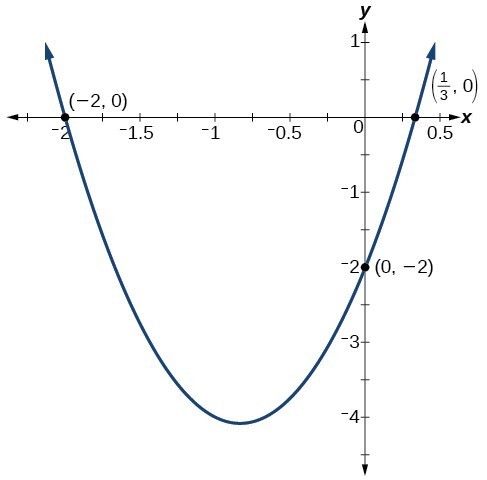
How To: Given a quadratic function, find the x-intercepts by rewriting in standard form.
- Substitute a and b into [latex]h=-\frac{b}{2a}[/latex].
- Substitute x = h into the general form of the quadratic function to find k.
- Rewrite the quadratic in standard form using h and k.
- Solve for when the output of the function will be zero to find the x-intercepts.
Example: Finding the Roots of a Parabola
Find the x-intercepts of the quadratic function [latex]f\left(x\right)=2{x}^{2}+4x - 4[/latex].Answer: We begin by solving for when the output will be zero.
[latex]0=2{x}^{2}+4x - 4[/latex]
Because the quadratic is not easily factorable in this case, we solve for the intercepts by first rewriting the quadratic in standard form.[latex]f\left(x\right)=a{\left(x-h\right)}^{2}+k[/latex]
We know that a = 2. Then we solve for h and k.[latex]\begin{array}{c}h=-\frac{b}{2a}\hfill & \hfill & \hfill & k=f\left(-1\right)\hfill \\ \text{ }=-\frac{4}{2\left(2\right)}\hfill & \hfill & \hfill & \text{ }=2{\left(-1\right)}^{2}+4\left(-1\right)-4\hfill \\ \text{ }=-1\hfill & \hfill & \hfill & \text{ }=-6\hfill \end{array}[/latex]
So now we can rewrite in standard form.[latex]f\left(x\right)=2{\left(x+1\right)}^{2}-6[/latex]
We can now solve for when the output will be zero.[latex]\begin{array}{c}0=2{\left(x+1\right)}^{2}-6\hfill \\ 6=2{\left(x+1\right)}^{2}\hfill \\ 3={\left(x+1\right)}^{2}\hfill \\ x+1=\pm \sqrt{3}\hfill \\ x=-1\pm \sqrt{3}\hfill \end{array}[/latex]
The graph has x-intercepts at [latex]\left(-1-\sqrt{3},0\right)[/latex] and [latex]\left(-1+\sqrt{3},0\right)[/latex].Analysis of the Solution
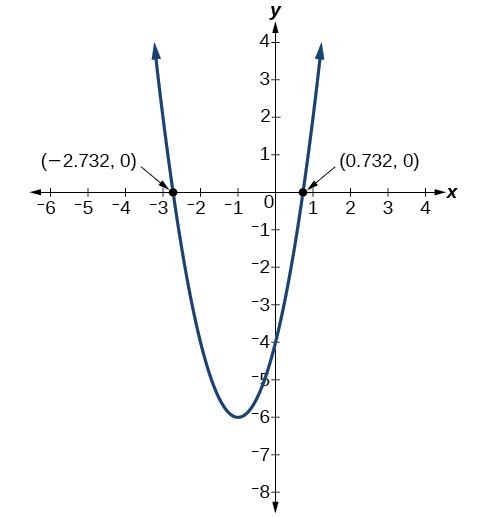 We can check our work by graphing the given function on a graphing utility and observing the roots.
We can check our work by graphing the given function on a graphing utility and observing the roots.
Try It
Find the y-intercept for the function [latex]g\left(x\right)=13+{x}^{2}-6x[/latex].Answer: y-intercept at (0, 13)
Complex Roots
Now you will hopefully begin to understand why we introduced complex numbers at the beginning of this module. Consider the following function: [latex]f(x)=x^2+2x+3[/latex], and it's graph below: Does this function have roots? It's probably obvious that this function does not cross the x-axis, therefore it doesn't have any x-intercepts. Recall that the x-intercepts of a function are found by setting the function equal to zero:
Does this function have roots? It's probably obvious that this function does not cross the x-axis, therefore it doesn't have any x-intercepts. Recall that the x-intercepts of a function are found by setting the function equal to zero:
[latex]x^2+2x+3=0[/latex]
In the next example, we will solve this equation. You will see that there are roots, but they are not x-intercepts because the function does not contain (x,y) pairs that are on the x-axis. We call these complex roots. By setting the function equal to zero and using the quadratic formula to solve, you will see that the roots contain complex numbers:[latex]x^2+2x+3=0[/latex]
Example
Find the x-intercepts of the quadratic function. [latex]f(x)=x^2+2x+3[/latex]Answer: The x-intercepts of the function [latex]f(x)=x^2+2x+3[/latex] are found by setting it equal to zero, and solving for x since the y values of the x-intercepts are zero. First, identify a, b, c.
[latex]\begin{array}{ccc}x^2+2x+3=0\\a=1,b=2,c=3\end{array}[/latex]
Substitute these values into the quadratic formula.[latex]\begin{array}{c}x=\frac{-b\pm \sqrt{{b}^{2}-4ac}}{2a}\\=\frac{-2\pm \sqrt{{2}^{2}-4(1)(3)}}{2(1)}\\=\frac{-2\pm \sqrt{4-12}}{2} \\=\frac{-2\pm \sqrt{-8}}{2}\\\frac{-2\pm 2i\sqrt{2}}{2} \\-1\pm i\sqrt{2}=-1+\sqrt{2},-1-\sqrt{2}\end{array}[/latex]
The solutions to this equations are complex, therefore there are no x-intercepts for the function [latex]f(x)=x^2+2x+3[/latex] in the set of real numbers that can be plotted on the Cartesian Coordinate plane. The graph of the function is plotted on the Cartesian Coordinate plane below: Graph of quadratic function with no x-intercepts in the real numbers.
Graph of quadratic function with no x-intercepts in the real numbers.The Discriminant
The quadratic formula not only generates the solutions to a quadratic equation, it tells us about the nature of the solutions. When we consider the discriminant, or the expression under the radical, [latex]{b}^{2}-4ac[/latex], it tells us whether the solutions are real numbers or complex numbers, and how many solutions of each type to expect. In turn, we can then determine whether a quadratic function has real or complex roots. The table below relates the value of the discriminant to the solutions of a quadratic equation.| Value of Discriminant | Results |
|---|---|
| [latex]{b}^{2}-4ac=0[/latex] | One repeated rational solution |
| [latex]{b}^{2}-4ac>0[/latex], perfect square | Two rational solutions |
| [latex]{b}^{2}-4ac>0[/latex], not a perfect square | Two irrational solutions |
| [latex]{b}^{2}-4ac<0[/latex] | Two complex solutions |
A General Note: The Discriminant
For [latex]a{x}^{2}+bx+c=0[/latex], where [latex]a[/latex], [latex]b[/latex], and [latex]c[/latex] are real numbers, the discriminant is the expression under the radical in the quadratic formula: [latex]{b}^{2}-4ac[/latex]. It tells us whether the solutions are real numbers or complex numbers and how many solutions of each type to expect.Example
Use the discriminant to find the nature of the solutions to the following quadratic equations:- [latex]{x}^{2}+4x+4=0[/latex]
- [latex]8{x}^{2}+14x+3=0[/latex]
- [latex]3{x}^{2}-5x - 2=0[/latex]
- [latex]3{x}^{2}-10x+15=0[/latex]
Answer: Calculate the discriminant [latex]{b}^{2}-4ac[/latex] for each equation and state the expected type of solutions.
- [latex]{x}^{2}+4x+4=0[/latex][latex]{b}^{2}-4ac={\left(4\right)}^{2}-4\left(1\right)\left(4\right)=0[/latex]. There will be one repeated rational solution.
- [latex]8{x}^{2}+14x+3=0[/latex][latex]{b}^{2}-4ac={\left(14\right)}^{2}-4\left(8\right)\left(3\right)=100[/latex]. As [latex]100[/latex] is a perfect square, there will be two rational solutions.
- [latex]3{x}^{2}-5x - 2=0[/latex][latex]{b}^{2}-4ac={\left(-5\right)}^{2}-4\left(3\right)\left(-2\right)=49[/latex]. As [latex]49[/latex] is a perfect square, there will be two rational solutions.
- [latex]3{x}^{2}-10x+15=0[/latex][latex]{b}^{2}-4ac={\left(-10\right)}^{2}-4\left(3\right)\left(15\right)=-80[/latex]. There will be two complex solutions.
- If [latex]b^{2}-4ac>0[/latex], then the number underneath the radical will be a positive value. You can always find the square root of a positive, so evaluating the Quadratic Formula will result in two real solutions (one by adding the positive square root, and one by subtracting it).
- If [latex]b^{2}-4ac=0[/latex], then you will be taking the square root of 0, which is 0. Since adding and subtracting 0 both give the same result, the "[latex]\pm[/late]" portion of the formula doesn't matter. There will be one real repeated solution.
- If [latex]b^{2}-4ac<0[/latex], then the number underneath the radical will be a negative value. Since you cannot find the square root of a negative number using real numbers, there are no real solutions. However, you can use imaginary numbers. You will then have two complex solutions, one by adding the imaginary square root and one by subtracting it.
Example
Use the discriminant to determine how many and what kind of solutions the quadratic equation [latex]x^{2}-4x+10=0[/latex] has.Answer: Evaluate [latex]b^{2}-4ac[/latex]. First note that [latex]a=1,b=−4[/latex], and [latex]c=10[/latex].
[latex]\begin{array}{c}b^{2}-4ac\\\left(-4\right)^{2}-4\left(1\right)\left(10\right)\end{array}[/latex]
The result is a negative number. The discriminant is negative, so the quadratic equation has two complex solutions.[latex]16–40=−24[/latex]
Answer
The quadratic equation [latex]x^{2}-4x+10=0[/latex] has two complex solutions.Applications With Quadratic Functions
There are many real-world scenarios that involve finding the maximum or minimum value of a quadratic function, such as applications involving area and revenue.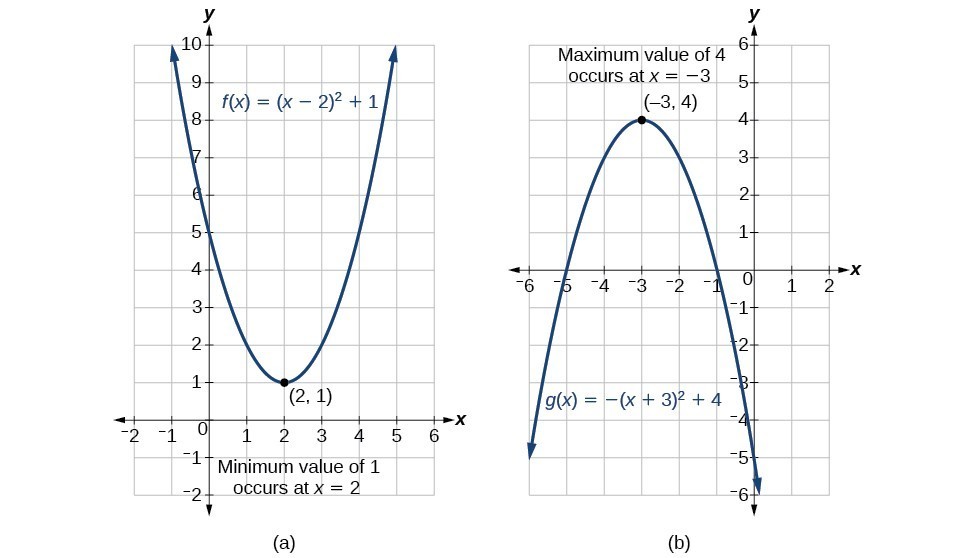
Example: Finding the Maximum Value of a Quadratic Function
A backyard farmer wants to enclose a rectangular space for a new garden within her fenced backyard. She has purchased 80 feet of wire fencing to enclose three sides, and she will use a section of the backyard fence as the fourth side.- Find a formula for the area enclosed by the fence if the sides of fencing perpendicular to the existing fence have length L.
- What dimensions should she make her garden to maximize the enclosed area?
Answer:
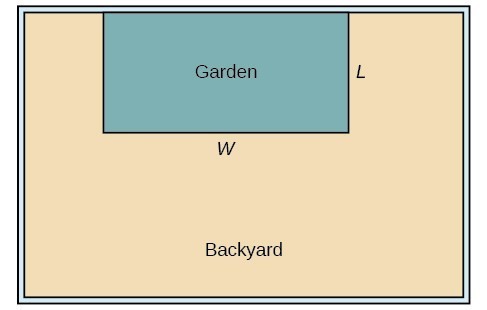 Let’s use a diagram such as the one above to record the given information. It is also helpful to introduce a temporary variable, W, to represent the width of the garden and the length of the fence section parallel to the backyard fence.
Let’s use a diagram such as the one above to record the given information. It is also helpful to introduce a temporary variable, W, to represent the width of the garden and the length of the fence section parallel to the backyard fence.
- We know we have only 80 feet of fence available, and [latex]L+W+L=80[/latex], or more simply, [latex]2L+W=80[/latex]. This allows us to represent the width, W, in terms of L. [latex]W=80 - 2L[/latex]Now we are ready to write an equation for the area the fence encloses. We know the area of a rectangle is length multiplied by width, so[latex]\begin{array}{l}\text{ }A=LW=L\left(80 - 2L\right)\hfill \\ A\left(L\right)=80L - 2{L}^{2}\hfill \end{array}[/latex]This formula represents the area of the fence in terms of the variable length L. The function, written in general form, is[latex]A\left(L\right)=-2{L}^{2}+80L[/latex].
- The quadratic has a negative leading coefficient, so the graph will open downward, and the vertex will be the maximum value for the area. In finding the vertex, we must be careful because the equation is not written in standard polynomial form with decreasing powers. This is why we rewrote the function in general form above. Since a is the coefficient of the squared term, [latex]a=-2,b=80[/latex], and [latex]c=0[/latex].
[latex]\begin{array}{l}h=-\frac{80}{2\left(-2\right)}\hfill & \hfill & \hfill & \hfill & k=A\left(20\right)\hfill \\ \text{ }=20\hfill & \hfill & \text{and}\hfill & \hfill & \text{ }=80\left(20\right)-2{\left(20\right)}^{2}\hfill \\ \hfill & \hfill & \hfill & \hfill & \text{ }=800\hfill \end{array}[/latex]
The maximum value of the function is an area of 800 square feet, which occurs when [latex]L=20[/latex] feet. When the shorter sides are 20 feet, there is 40 feet of fencing left for the longer side. To maximize the area, she should enclose the garden so the two shorter sides have length 20 feet and the longer side parallel to the existing fence has length 40 feet.Analysis of the Solution
This problem also could be solved by graphing the quadratic function. We can see where the maximum area occurs on a graph of the quadratic function below.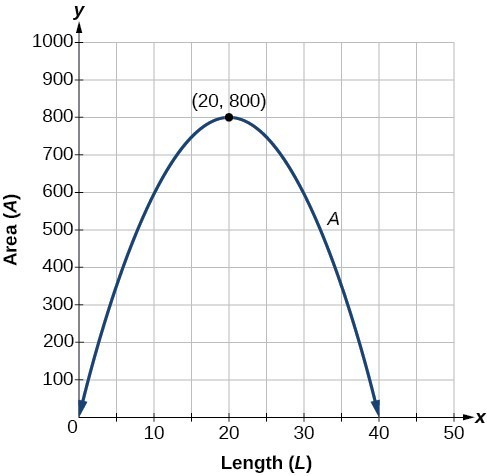
How To: Given an application involving revenue, use a quadratic equation to find the maximum.
- Write a quadratic equation for revenue.
- Find the vertex of the quadratic equation.
- Determine the y-value of the vertex.
Example: Finding Maximum Revenue
The unit price of an item affects its supply and demand. That is, if the unit price goes up, the demand for the item will usually decrease. For example, a local newspaper currently has 84,000 subscribers at a quarterly charge of $30. Market research has suggested that if the owners raise the price to $32, they would lose 5,000 subscribers. Assuming that subscriptions are linearly related to the price, what price should the newspaper charge for a quarterly subscription to maximize their revenue?Answer: Revenue is the amount of money a company brings in. In this case, the revenue can be found by multiplying the price per subscription times the number of subscribers, or quantity. We can introduce variables, p for price per subscription and Q for quantity, giving us the equation [latex]\text{Revenue}=pQ[/latex]. Because the number of subscribers changes with the price, we need to find a relationship between the variables. We know that currently [latex]p=30[/latex] and [latex]Q=84,000[/latex]. We also know that if the price rises to $32, the newspaper would lose 5,000 subscribers, giving a second pair of values, [latex]p=32[/latex] and [latex]Q=79,000[/latex]. From this we can find a linear equation relating the two quantities. The slope will be
[latex]\begin{array}{c}m=\frac{79,000 - 84,000}{32 - 30}\hfill \\ \text{ }=\frac{-5,000}{2}\hfill \\ \text{ }=-2,500\hfill \end{array}[/latex]
This tells us the paper will lose 2,500 subscribers for each dollar they raise the price. We can then solve for the y-intercept.[latex]\begin{array}{c}\text{ }Q=-2500p+b\hfill & \text{Substitute in the point }Q=84,000\text{ and }p=30\hfill \\ 84,000=-2500\left(30\right)+b\hfill & \text{Solve for }b\hfill \\ \text{ }b=159,000\hfill & \hfill \end{array}[/latex]
This gives us the linear equation [latex]Q=-2,500p+159,000[/latex] relating cost and subscribers. We now return to our revenue equation.[latex]\begin{array}{c}\text{Revenue}=pQ\hfill \\ \text{Revenue}=p\left(-2,500p+159,000\right)\hfill \\ \text{Revenue}=-2,500{p}^{2}+159,000p\hfill \end{array}[/latex]
We now have a quadratic function for revenue as a function of the subscription charge. To find the price that will maximize revenue for the newspaper, we can find the vertex.[latex]\begin{array}{c}h=-\frac{159,000}{2\left(-2,500\right)}\hfill \\ \text{ }=31.8\hfill \end{array}[/latex]
The model tells us that the maximum revenue will occur if the newspaper charges $31.80 for a subscription. To find what the maximum revenue is, we evaluate the revenue function.[latex]\begin{array}{c}\text{maximum revenue}=-2,500{\left(31.8\right)}^{2}+159,000\left(31.8\right)\hfill \\ \text{ }=2,528,100\hfill \end{array}[/latex]
Analysis of the Solution
This could also be solved by graphing the quadratic. We can see the maximum revenue on a graph of the quadratic function.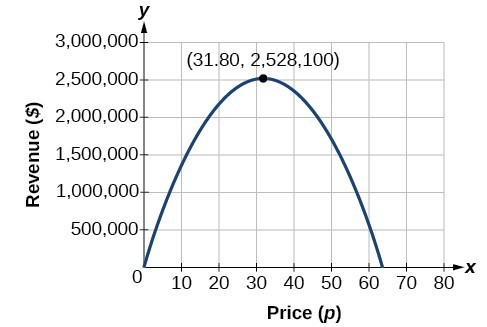
Key Equations
The quadratic formula [latex]x=\frac{-b\pm \sqrt{{b}^{2}-4ac}}{2a}[/latex] The discriminant is defined as [latex]b^2-4ac[/latex]Key Concepts
- The zeros, or x-intercepts, are the points at which the parabola crosses the x-axis. The y-intercept is the point at which the parabola crosses the y-axis.
- The vertex can be found from an equation representing a quadratic function.
- A quadratic function’s minimum or maximum value is given by the y-value of the vertex.
- The minium or maximum value of a quadratic function can be used to determine the range of the function and to solve many kinds of real-world problems, including problems involving area and revenue.
- Some quadratic equations must be solved by using the quadratic formula.
- The vertex and the intercepts can be identified and interpreted to solve real-world problems.
- Some quadratic functions have complex roots
- discriminant
- the value under the radical in the quadratic formula, [latex]b^2-4ac[/latex], which tells whether the quadratic has real or complex roots
- vertex
- the point at which a parabola changes direction, corresponding to the minimum or maximum value of the quadratic function
Glossary
- vertex form of a quadratic function
- another name for the standard form of a quadratic function
- zeros
- in a given function, the values of x at which y = 0, also called roots
Licenses & Attributions
CC licensed content, Original
- Revision and Adaptation. Provided by: Lumen Learning License: CC BY: Attribution.
- Question ID 121416, 121401. Provided by: Lumen Learning License: CC BY: Attribution. License terms: IMathAS Community License CC-BY + GPL.
CC licensed content, Shared previously
- College Algebra. Provided by: OpenStax Authored by: Abramson, Jay et al.. Located at: https://openstax.org/books/college-algebra/pages/1-introduction-to-prerequisites. License: CC BY: Attribution. License terms: Download for free at http://cnx.org/contents/[email protected].
- Question ID 15809. Authored by: Sousa, James, mb Lippman, David. License: CC BY: Attribution. License terms: IMathAS Community License CC-BY + GPL.
- Question ID 35145. Authored by: Jim Smart. License: CC BY: Attribution. License terms: IMathAS Community License CC-BY + GPL.
- Question ID 2451. Authored by: Anderson, Tophe. License: CC BY: Attribution. License terms: IMathAS Community License CC-BY + GPL.
- Question ID 15552. Authored by: David Lippman. License: CC BY: Attribution. License terms: IMathAS Community License CC-BY + GPL.

